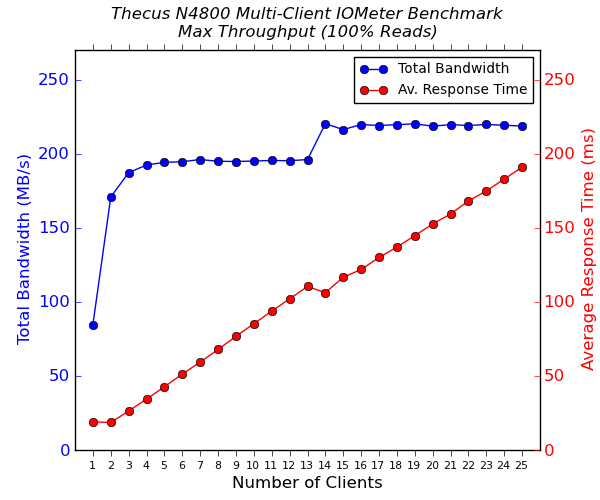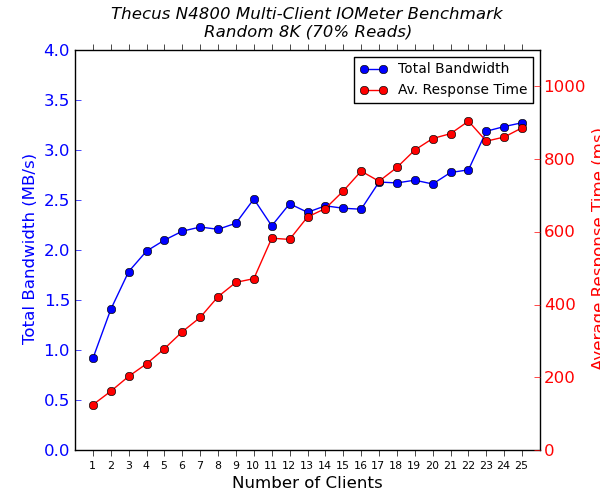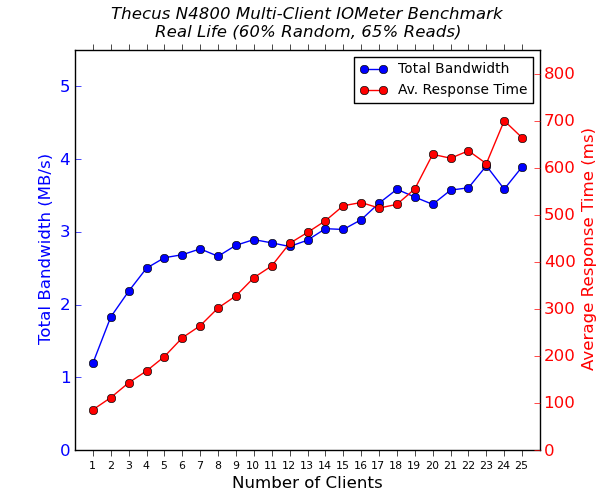Updating the 2012 AnandTech SMB / SOHO NAS Testbed
by Ganesh T S on November 29, 2012 3:00 PM EST- Posted in
- IT Computing
- NAS
Thecus N4800: Testbed in Action
We have been evaluating the Thecus N4800, a 4-bay NAS unit based on the Atom D2700, over the last few months. A full length detailed reviewhas been put on the backburner because of some firmware issues related to RAID migration and rebuild. However, many other reviews have observed that it is one of the top performers with respect to raw data access speeds. We had put the unit through the new test suite with four disks in RAID5 in our previous piece, and the N4800 had emerged with its head held high even with 12 simultaneous clients.
We repeated our test after increasing the number of clients to 25. The following four graphs show the total available bandwidth and the average response time while being subject to different types of workloads through IOMeter. IOMeter also reports various other metrics of interest such as maximum response time, read and write IOPS, separate read and write bandwidth figures etc. Selected metrics from the evaluation of the Thecus N4800 are available here.




The updated testbed finally gives pointers towards the potential weaknesses of the Thecus N4800. Under environments with more than 15 clients doing simultaneous sequential reads and writes, performance starts to degrade. On the other hand, pure sequential reads manage to saturate the link-aggregated GbE ports even up to 25 clients.
One of the important aspects not reflected in the above graph is the maximum response time. The values are available in the detailed results summary. Some transactions (even sequential reads) can take around 30 seconds to complete, and this might not be acceptable for some usage scenarios.










23 Comments
View All Comments
GullLars - Saturday, December 1, 2012 - link
This was a very interresting read, but why the revodrive hybrid? With the cost of the entire system, why not just go for a Revodrive 3 X2 960GB? That massively reduce VM boot times, and eliminate or push forward any IO bottlenecks the 13 VMs sharing the drive may encounter.This once again reminds me that the industry has been way to slow to make 10GbE avalible to the masses, or even powerusers and enthusiasts. I've been running SSD RAIDs for years now, and i'd like to move my HDD RAID to a fileserver, but the bottleneck from GbE has kept me from it. It would also be awesome for LANs, even if the switch only had 1-2 10GbE ports.
batguiide - Sunday, December 9, 2012 - link
Thanks for these tips! I love the tip about checking where the model is in the store. I just finished reading another article that has some more research based tips about making sure you get the best big ticket items for you, which I also found useful. website:[socanpower,ca]Hrel - Friday, December 14, 2012 - link
Some reviews on those newer NAS units that are based on ARM would be GREAT! I'm extremely cautious of how good that could work. But then again my current NAS is running a Pentium 4 540 I think? 3GHZ hyperthreaded. Works, but not the fastest thing. The CPU is clearly the bottleneck.